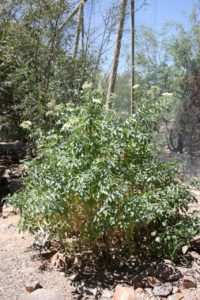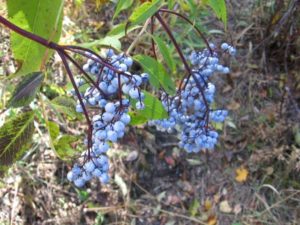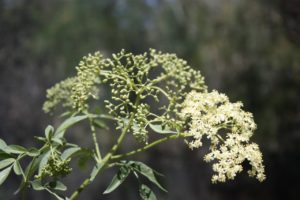By Dr. Jacqueline A. Soule
More clients today are asking for edible landscaping, and a number now also ask for pollinator friendly landscaping. To top it off, many want native plants, and low water options. Not to worry – there are a number of lovely landscape plants that fit the bill, and today we will look at the elder or elderberry, Sambucus.
Native to the Southwest is the “Mexican elderberry” and just to confuse everyone, the common name is applied to two very different species. Be sure you get the right species for your region.

Sambucus cerulea
In the lower elevation areas of the Sonoran and Chihuahuan deserts you will find a heat tolerant tree best called Sambucus mexicana. The higher elevations of the Mohave and Great Basin deserts through Nevada and Utah, are home to a less heat tolerant, more shrubby species, Sambucus cerulea (also written caerulea). Common names for both include saúco, tapiro, flor de sauz, capulin silvestre (Spanish); and shiksh (O’odham).
Sambucus mexicana is a deciduous tree that can reach 15 to 25 feet high, spreading to 20 feet wide when grown in full sun in average, well-drained soil and with adequate moisture. A DBH of 18 inches is a possibility, so plan placement carefully. Often multi-trunked when young, some training may be required.
Sambucus caerulea is a more of a tall shrub or perhaps a short multi-trunked tree, reaching to 15 to 20 feet tall and as wide. It also does best in full sun with well-drained soil and moderate moisture.
About water use. Compared with a yucca, these are not low water plants. But compared to sycamore or ash, they are low water indeed. Elderberries of both species were once common in canyons and along the year-round rivers that used to criss-cross our region, but as the water table retreated, they became less common.
Elderberries are in the Caprifoliaceae or Honeysuckle Family (although some botanists now consider this the moschatel family, Adoxaceae). The family includes viburnum (Viburnum), a common landscape shrub in north and eastern USA. Newcomers to the Southwest are often obscurely comforted to learn that a plant they know from “Back East” has a Southwest cousin. This helps make their new landscape less of an unknown.

Utah Sambucus cerulea
There are 20 to 30 species of elder found around the world, depending on which taxonomist you ask. Elder is very versatile and various parts of the plant have uses that include: cosmetic, culinary, dye, edible flowers, medicinal, ornamental, and to attract wildlife. All species have edible berries, although some species can be toxic without special preparation. The native species can be eaten right off the plant, but moderation is advised whenever trying a new fruit or herb.
Wildlife prize the berries, since the fruit is sweet and both the berry and the seeds inside them are rich in waxes and oils. To share the landscape with wildlife, you can harvest for jelly and juice, process the fruit, then put the seedy pulp back out for the birds to feast upon. And yes, it does stain the flagstones for a while, but a few good rains and the stains wash away. A small price to pay to watch the cardinals and phainopepla cavort.

Sumbucus cerulea
Dr. Jacqueline Soule is the author of a number of books on gardening and landscaping in our unique Southwestern arid environment. Her next book is Month-by-Month Gardening in Arizona, Nevada and New Mexico, published by Cool Springs Press and due in Fall 2016. She will speak at Desert Green on edible landscaping this October.
